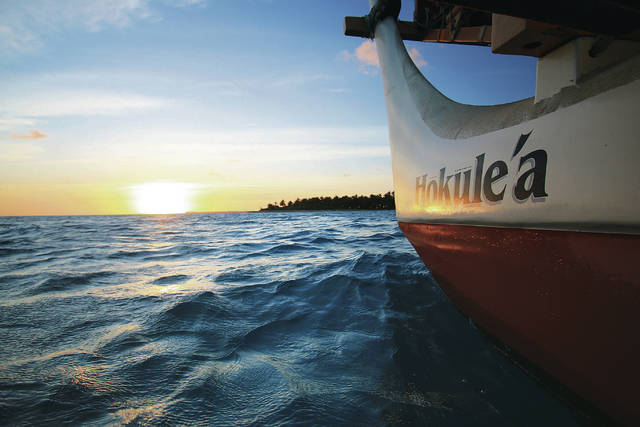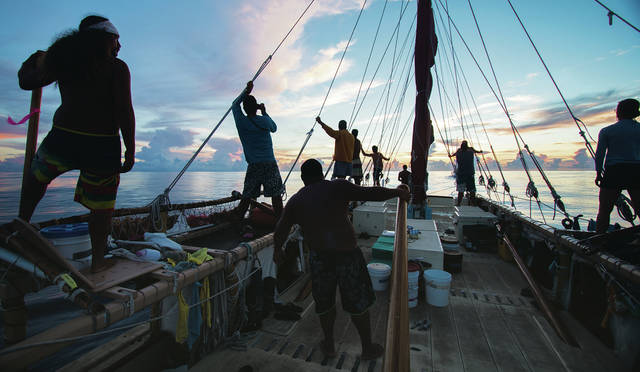Hokule‘a’s voyage aims to rally support around the globe

COURTESY ‘OIWI TV

COURTESY ‘OIWI TV
Crew members line the rails of the Hokule‘a hoping to catch sight of land in the Virgin Islands after sailing from Natal, Brazil.


One of the most harrowing tests of the whole undertaking came on Oct. 14, 2015.
Half a world away from Hawaii, on the voyage’s most dangerous leg, the Hokule‘a fled a fierce ocean storm that had already torn part of its canvas covering. It sought safe harbor in Maputo, Mozambique.
For the first time in recorded history, a Polynesian sailing canoe had reached the African continent. But its sailors had also detoured to an unscheduled port where nobody expected them. The foreign double-hulled craft would have to stay offshore in Maputo’s frigid bay tied to its escort boat, Gershon II, which dropped anchor.
* View the special section: The Homecoming
—
>> Leg 1: Crew departs Hilo heading toward new experiences, unfamiliar waters
>> Leg 2: After Australia visit, crew member gets into trouble during rough seas
>> Leg 3: Treacherous trip to South Africa ends with connection to early civilization
>> Leg 4: After sailing to Brazil, the crew makes noteworthy visit to Cuba
>> Leg 5: East Coast segment honors multiple Native American tribes
>> Leg 6: Budding crew leaders take the helm as they head home
>> Journey tests Hokule’a crews’ strengths, but also offers liberation
>> Hokule’a’s future plans include visits to 30 ports across state
>> Apprentices hone skills under master navigators’ guidance
>> Hokule’a crews spread message via video chats, email and tours
There, in the darkness and the driving rain, exhausted crew members worked to keep the Hokule‘a downwind of the Gershon II as a miniature perfect storm of gale-force winds and fast-shifting currents tossed around the two vessels.
Eventually they would collide. The impact left a softball-size hole in the Hokule‘a’s starboard bow — and some aboard in tears.
Don't miss out on what's happening!
Stay in touch with breaking news, as it happens, conveniently in your email inbox. It's FREE!
“This moment will break your crew. It’ll break it,” captain Nainoa Thompson recalled weeks later. “And we said, this moment where Hokule‘a was damaged will not define the mana of this crew. What will define it is because we took care of it.”
The crew regrouped. Its members improvised repairs and reached South Africa as planned. Once safely in Cape Town, they were embraced by one of the world’s most celebrated champions for human rights.
“Human beings can be so courageous,” Archbishop Emeritus Desmond Tutu told them, sitting on his office balcony near the city waterfront. “Human beings can be so inventive that they are ready to take the risks sailing around the world.”
“That’s amazing and uplifting,” he added with a grin.
In the past three years, more than 250 volunteer sailors joined one of the most ambitious feats in Hawaii’s history: an around-the-world canoe voyage dubbed Malama Honua (“Care for the Earth”).
Each of those sailors was tested in their own way.
They lived out of cramped hulls, stuffed their belongings into waterproof coolers and managed what sleep they could on plywood boards and foam pads. They steered through the night using the canoe’s large stern sweeps, often fighting fatigue to stay on course.
They strapped on safety harnesses to change sails and tighten lines; hauled heavy anchors out of the water; loaded bulky supplies; cooked hearty meals for a dozen people using a camping stove; and showered with pails of seawater scooped from the stern.
They navigated vast oceans as well as their own interpersonal relationships.
“You get together with a group of people that you don’t necessarily know and you become so close to them, they become family,” crew member Kaniela Hoku Lyman-Mersereau said. “The wayfinding is really finding your way around people. Not only getting along, but meeting new people. There’s always something going on.”
Supported by numerous other volunteers back home, these sailors spent weeks away from Hawaii in far-flung ports and on the open ocean — pushing the canoe past its Pacific boundaries and into distant communities that had never seen such a curious sea vessel.
They explored temple ruins, participated in sacred welcome ceremonies, dived on pristine coral reefs, greeted world leaders, toured national parks and the NASA Kennedy Space Center, and paid tribute to local indigenous groups wherever they could.
They sailed more than 46,000 miles, visiting more than 150 ports in 19 countries. The Oahu-based Polynesian Voyaging Society reports raising over $10 million in cash — the bulk from Hawaii businesses and charitable foundations — and relying on about $20 million more in volunteer sweat and in-kind services to make the whole thing happen.
It was all for a larger purpose. With Malama Honua, the Hokule‘a aimed to rally support around the globe to protect marine resources and preserve local cultures.
“We’re on the wrong sail plan,” Thompson would often tell audiences in ports around the world.
The oceans, which generate about 70 percent of the world’s oxygen, are warming, rising and growing more acidic. Coral reefs around the world are dying at rates never before recorded, researchers say. Overfishing is pushing tuna and other large fish populations to the brink. A gyre of trash the size of Texas continues to grow in the Pacific.
On tiny Henderson Island, which the Hokule‘a briefly visited during its 2017 stay in the Pitcairns, scientists recently encountered an estimated 38 million pieces of debris. Most of it was plastic. They estimate that 13,000 new pieces of debris wash up on the remote Pacific island every day.
Thompson, who’s also president of PVS, and the voyage’s organizers felt they had to do something to address the mounting environmental crises. “You can keep the canoes tied to the dock, but you can’t complain,” he told Tuiatua Tupua Tamasese Efi, the Samoan head of state, during the voyage’s visit to Apia, Samoa.
Malama Honua’s success was far from guaranteed. Sailing around the world meant that the Hokule‘a, a 62-foot-long vessel that’s little more than wood, fiberglass and about 5 miles of lashing and rigging, would face the threat of hurricanes, pirates, rogue waves and what organizers projected could be as many as five man-overboard emergencies. (In the end they would report having just one man-overboard, with that sailor safely rescued.)
Once the sail was underway, voyage organizers found much of the long-term weather data they had collected to be unreliable, with more hurricanes brewing and the winds changing.
The “thousands” of decisions Thompson had to make in the past three years to help keep crews safe have taken their toll, he said. “I’m really tired,” he said. “The reason why I’m exhausted is that responsibility never goes away.”
Still, he believes the journey was worth it and that the greater danger would have been to keep the Hokule‘a tied to the dock on Sand Island rather than to face the voyage’s risks.
As of early June this epic voyage of aloha was poised to succeed with a new Hokule‘a captain, Pomai Bertelmann, and navigator, Ka‘iulani Murphy, as they guided the canoe safely home on the final stretch. Apprentice navigators were bringing its escort canoe, Hikianalia, safely to Hawaii, too.
Around the globe the canoes encountered thousands of people concerned with protecting the environment for future generations. They collected community stories, highlighted conservation efforts and built a unique worldwide network to help further the cause.
“There weren’t really 13 people — there were thousands of people” aboard the Hokule‘a, said crew member Linda Furuto, a University of Hawaii College of Education professor.
One afternoon in Apia, as the canoes made final preparations to sail north toward Tokelau, Eric Co noticed a Samoan man chanting to them. Co turned to Junior “Rex” Lokeni, a fellow Hokule‘a crew member from Samoa whom Co met days earlier, and asked him to translate to English.
“We are family. You have come from us. Your blood is my blood. Your bones are my bones,” Lokeni translated. “So when you sail, I sail with you.”
Honolulu Star-Advertiser reporter Marcel Honoré reported from aboard the Hokule‘a in the Samoan islands, New Zealand and French Polynesia. He also reported on the Malama Honua voyage from Cape Town, South Africa.



